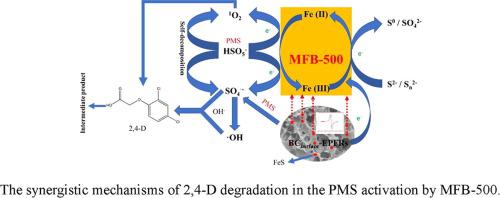Chemical Engineering Journal ( IF 13.3 ) Pub Date : 2021-03-04 , DOI: 10.1016/j.cej.2021.129238 Qiaofeng Hong , Chao Liu , Zhenbei Wang , Ruoyu Li , Xiaoliang Liang , Yiping Wang , Yuting Zhang , Zilong Song , Zhihui Xiao , Tingyu Cui , Beibei Heng , Bingbing Xu , Fei Qi , Amir Ikhlaq

|
A highly active mediator (magnetic FeS@biochar, MFB) for peroxymonosulfate (PMS) activation was prepared by employing FeSO4·7H2O and poplar sawdust as the precursor, for pesticides remediation in soil and groundwater. The magnetic FeS@biochar prepared at 500 °C (MFB-500) did not only showed good performance in activating PMS to degrade 2,4-dichlorophenoxyacetic acid (2,4-D), but also longer lifetime. Due to the introduction of FeS, the defect degree of MFB-500 was higher according to Raman spectra result and favored in PMS activation. The X-ray photoelectron spectroscopy (XPS) and Mössbauer spectra confirmed that sulfur species promoted the regeneration of Fe(II). Moreover, EPFRs also showed an electron shuttle to enhance the recycle of Fe(II)/Fe(III) and increased the PMS activation performance. Electron paramagnetic resonance (EPR) spectroscopy identified SO4•-, •OH and 1O2 as the reactive oxygen species (ROS) in 2,4-D degradation. The optimized reaction parameters of MFB-500/PMS were determined as [MFB-500] = 700 mg/L, [PMS] = 2.6 mM, [2,4-D] = 0.045 mM. Meanwhile, the interfacial adsorption and catalytic reaction of 2,4-D degradation by MFB-500/PMS is accurately described by a newly mixed order kinetics model with adsorption and decay dominant rate constants kα and kγ, respectively. The effect of pH0 and coexisting anions was also studied, and it was found that acidic conditions are conducive to the degradation of 2,4-D, while alkaline conditions inhibited. Cl-, NO3– and SO42- play a slight inhibitory effect, and HCO3– and H2PO4- will play a significant inhibitory effect. This work provides a promising approach to the rational design of high-performance active mediators for environmental remediation.
中文翻译:

磁性FeS @ biochar中的硫和生物炭将电子转移增强Fe(II)/ Fe(III)循环,转化为活性过氧单硫酸盐以降解2,4-二氯苯氧基乙酸
通过使用FeSO 4 ·7H 2制备用于过氧化一硫酸盐(PMS)活化的高活性介体(磁性FeS @ biochar,MFB)。O和白杨木屑为前体,用于土壤和地下水中的农药修复。在500°C下制备的磁性FeS @ biochar(MFB-500)不仅在激活PMS降解2,4-二氯苯氧基乙酸(2,4-D)方面表现出良好的性能,而且使用寿命更长。由于引入了FeS,根据拉曼光谱结果,MFB-500的缺陷度更高,有利于PMS活化。X射线光电子能谱(XPS)和Mössbauer光谱证实,硫物种促进了Fe(II)的再生。此外,EPFR还显示出电子穿梭来增强Fe(II)/ Fe(III)的再循环并提高PMS活化性能。电子顺磁共振(EPR)光谱鉴定出SO 4 •-,•OH和1 O 2作为2,4-D降解中的活性氧(ROS)。确定MFB-500 / PMS的最佳反应参数为[MFB-500] = 700 mg / L,[PMS] = 2.6 mM,[2,4-D] = 0.045 mM。同时,界面吸附,并通过MFB-500 2,4-d降解的催化反应/ PMS被准确地由新的混合级动力学模型与吸附描述和衰减速率主导常数ķ α和ķ γ分别。还研究了pH 0和共存阴离子的影响,发现酸性条件有利于2,4-D的降解,而碱性条件则被抑制。氯-,NO 3 -和SO 4 2-玩的轻微抑制效果,HCO 3 -和H 2 PO 4 -将起到显著抑制作用。这项工作为合理设计高性能主动介体进行环境修复提供了一种有前途的方法。











































 京公网安备 11010802027423号
京公网安备 11010802027423号